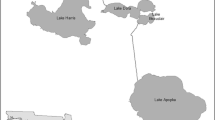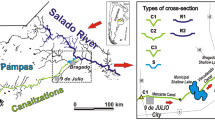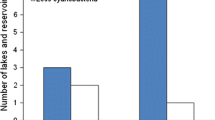Abstract
Diatom blooms in the middle reaches of the shallow, freshwater, Hunter River, Australia, are a frequent nuisance to river users. During a 4-year study, blooms of Cyclotella meneghiniana and Nitzschia spp. coincided with water temperatures above 23°C and flows below 400 Ml d−1 that lasted for more than 12 days. Redundancy analysis showed that water temperature was positively related, and antecedent flow was negatively related, to the abundance of both taxa. Addition experiments indicated that nutrients are seldom limiting to growth. It is suggested that a combination of faster growth rates at higher temperatures and longer retention times at low flows allows bloom populations to develop. Simulation modelling showed that flow regulation and water extraction have decreased flows in the river during summer, and consequently have probably increased the number of diatom blooms. Environmental flows have been provided to the river, but are not sufficient to prevent blooms. Discharges required for bloom suppression are described.








Similar content being viewed by others
References
Admiraal, W., P. Breugem, D. M. L. H. A. Jacobs & E. D. De Ruyter Van Steveninck, 1990. Fixation of dissolved silicate and sedimentation of biogenic silicate in the lower river Rhine during diatom blooms. Biogeochemistry 9: 175–185.
Ainsworth, P., 1996. Draft Hunter Valley Strategic Water Management Plan. Department of Land and Water Conservation, Maitland, Australia.
APHA., 1998. Standard Methods for Examination of Water and Wastewater. APHA (American Public Health Association), AWWA (American Water Works Association), WPCF (Water Pollution Control Federation), Washington D.C., USA.
Chessman B. C. (ed.), 2003. Integrated Monitoring of Environmental Flows (IMEF); State Summary Report 1998–2000. Department of Infrastructure, Planning and Natural Resources, Sydney.
Chorus, I. & J. Bartram, 1999. Toxic Cyanobacteria in Water. World Health Organization, London.
de Jonge V. N., M. Elliott & E. Orive, 2002. Causes, historical development, effects and future challenges of a common environmental problem: eutrophication. Hydrobiologia 475–476: 1–19.
de Sève, M. A., 1993. Diatom bloom in the tidal freshwater zone of a turbid and shallow estuary, Rupert Bay (James Bay, Canada). Hydrobiologia 269–270: 225–233.
Garnier, J., G. Billen & M. Coste, 1995. Seasonal succession of diatoms and Chlorophyceae in the drainage network of the Seine River: observations and modelling. Limnology and Oceanography 40: 750–765.
Gorczyca, B. & D. London, 2003. Characterization of particles in slow sand filtration at North Caribou water treatment plant. Water Quality Research Journal of Canada 38: 153–168.
Gosselain, V., J. P. Descy & E. Everbecq, 1994. The phytoplankton community of the River Meuse, Belgium: seasonal dynamics (year 1992) and the possible incidence of zooplankton grazing. Hydrobiologia 289: 179–191.
Green, P. A., C. J. Vörösmarty, M. Meybeck, J. N. Galloway, B. J. Peterson & E. W. Boyer, 2004. Pre-industrial and contemporary fluxes of nitrogen through rivers: a global assessment based on typology. Biogeochemistry 68: 71–105.
Ha, K., M.-H. Jang & G.-J. Joo, 2003. Winter Stephanodiscus bloom development in the Nakdong River regulated by an estuary dam and tributaries. Hydrobiologia 506: 221–227.
Hötzel, G. & R. Croome, 1999. A Phytoplankton Methods Manual for Australian Freshwaters. Occasional Paper 22/99, Land & Water Resources Research & Development Corporation, Canberra.
Kiss, K. T. & S. I. Genkal, 1993. Winter blooms of centric diatoms in the River Danube and in its side arms near Budapest (Hungary). Hydrobiologia 269–270: 317–325.
Mitrovic, S. M., L. C. Bowling & R. T. Buckney, 2001a. Responses of phytoplankton to in-situ nutrient enrichment; potential influences on species dominance in a river. International Review of Hydrobiology 86: 285–298.
Mitrovic, S. M., L. C. Bowling & R. T. Buckney, 2001b. Variability in phytoplankton vertical distribution between the main channel and an embayment of a tidal freshwater river. Journal of Freshwater Ecology 16: 151–157.
Mitrovic, S. M., R. L. Oliver, C. Rees, L. C. Bowling & R. T. Buckney, 2003. Critical flow velocities for the growth and dominance of Anabaena circinalis in some turbid freshwater rivers. Freshwater Biology 48: 164–174.
Mitrovic, S. M., B. C. Chessman, L. C. Bowling & R. H. Cooke, 2006. Modelling suppression of cyanobacterial blooms by flow management in a lowland river. River Research and Applications 22: 109–114.
Montagnes, D. J. S & D. J. Franklin, 2001. Effect of temperature on diatom volume, growth rate, and carbon and nitrogen content: reconsidering some paradigms. Limnology and Oceanography 46: 2008–2018.
Reynolds, C. S., J. P. Descy & J. Padisák, 1994. Are phytoplankton dynamics in rivers so different from those in shallow lakes? Hydrobiologia 289: 1–7.
Simons, M., G. Podger & R. Cooke, 1996. IQQM––A hydrologic modelling tool for water resource and salinity management. Environmental Modelling and Software 11: 185–192.
Shafik, H. M., S. Herodek, L. Voros, M. Presing & K. T. Kiss, 1997. Growth of Cyclotella meneghiniana Kutz. I. Effects of temperature, light and low rate of nutrient supply. Annals of Limnology 33: 139–147.
Sherman B. S., I. T. Webster, G. J. Jones & R. L. Oliver, 1998. Transitions between Aulacoseira and Anabaena dominance in a turbid river weir pool. Limnology and Oceanography 43: 1902–1915.
Ter Braak, C. J. F., 1992. CANOCO––A FORTRAN Program for Canonical Community Ordination. Microcomputer Power, Ithaca, New York.
Webster, I. T., G. J. Jones, R. L. Oliver, M. Bormans & B. S. Sherman, 1995. Control strategies for cyanobacterial blooms in weir pools. Final grant report to the Natural Resource Management Strategy, Australia, Technical Report No. 119.
Acknowledgements
This work was funded under the NSW Government’s Integrated Monitoring of Environmental Flows Program. We thank the staff at the Water Environment Laboratory for sample analysis, in particular Jon Holliday for phytoplankton identification and counting. Review of this manuscript by Dr. Lee Bowling and Simon Williams is also greatly appreciated, as are the valuable comments from two anonymous reviewers.
Author information
Authors and Affiliations
Corresponding author
Additional information
Handling editor: D. Hamilton
Rights and permissions
About this article
Cite this article
Mitrovic, S.M., Chessman, B.C., Davie, A. et al. Development of blooms of Cyclotella meneghiniana and Nitzschia spp. (Bacillariophyceae) in a shallow river and estimation of effective suppression flows. Hydrobiologia 596, 173–185 (2008). https://doi.org/10.1007/s10750-007-9094-1
Received:
Revised:
Accepted:
Published:
Issue Date:
DOI: https://doi.org/10.1007/s10750-007-9094-1




